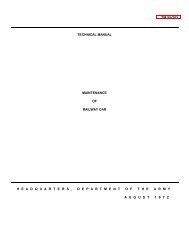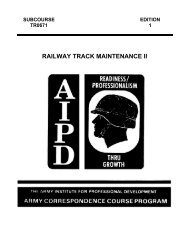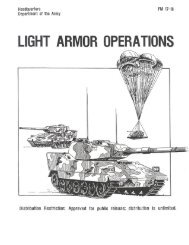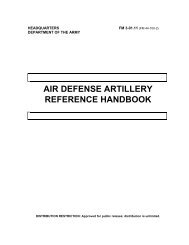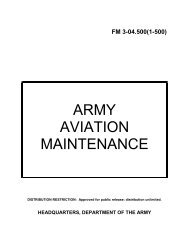fm 44-100 us army air and missile defense operations
fm 44-100 us army air and missile defense operations
fm 44-100 us army air and missile defense operations
Create successful ePaper yourself
Turn your PDF publications into a flip-book with our unique Google optimized e-Paper software.
FM <strong>44</strong>-<strong>100</strong><br />
4-22<br />
m<strong>us</strong>t be integrated into the supported comm<strong>and</strong>er's concept of the operation.<br />
The AD plan describes vertical <strong>and</strong> horizontal integration of <strong>air</strong> <strong>defense</strong><br />
systems across the width <strong>and</strong> depth of the battlefield <strong>and</strong> includes<br />
integration with joint <strong>and</strong> multinational forces.<br />
Air Defense Artillery Employment Guidelines<br />
4-113. Planning <strong>and</strong> positioning ADA resources involves applying six<br />
employment guidelines. The guidelines are mutual support, overlapping fires,<br />
balanced fires, weighted coverage, early engagement, <strong>and</strong> <strong>defense</strong> in depth<br />
(figure 4-3).<br />
4-114. Mutual support is achieved by positioning weapons so that the fires<br />
of one weapon can engage targets within the dead zone of the adjacent<br />
weapon system. For gun systems, this dead zone is <strong>us</strong>ually small. For <strong>missile</strong><br />
systems, the dead zone can be large <strong>and</strong> the need for mutual support is great.<br />
Mutual support can also be <strong>us</strong>ed to cover non-operational units or units at<br />
lower states of readiness.<br />
MUTUAL SUPPORT OVERLAPPING FIRES BALANCED FIRES<br />
Fires of one weapon can engage<br />
targets in dead zone of adjacent<br />
weapon.<br />
WEIGHTED COVERAGE EARLY ENGAGEMENT<br />
Most<br />
Likely<br />
AAA<br />
Concentrate fire on most likely<br />
enemy <strong>air</strong> avenue of approach.<br />
Engagement envelops of both<br />
weapons overlap.<br />
Position weapons <strong>and</strong> sensors<br />
so they engage before ordnance<br />
release.<br />
Figure 4-3. ADA Employment Guidelines<br />
Weapons positioned to deliver equal<br />
volumes of fires in all direction<br />
DEFENSE IN DEPTH<br />
Position weapons so threat comes under<br />
increasing volume of fire.<br />
4-115. Overlapping fires are achieved by positioning weapons so their<br />
engagement envelopes overlap. Beca<strong>us</strong>e of the many altitudes from which the<br />
enemy can attack or conduct RSTA <strong>operations</strong>, the <strong>defense</strong> planner m<strong>us</strong>t<br />
apply mutual support or overlapping fires vertically <strong>and</strong> horizontally.<br />
4-116. Balanced fires are achieved by positioning weapons to deliver an<br />
equal volume of fire in all directions. This may be necessary when <strong>air</strong> <strong>defense</strong>




